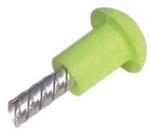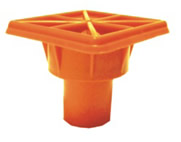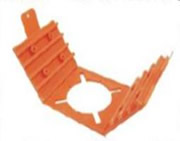The most important components of the CoverCaps family of products are the Disc-10 and HH-M.
These wolrdwide patented caps are characterized by a large square top surface in resilient plastic, designed to aid in spreading the energy in a fall over a larger surface of the human body, lessening the impact. Under the top a bellshaped metal insert is located which provides the protection against being impaled by the rebar in case of a fall. The bell shape is designed to aid in guiding the rebar to the most resistent location of the insert: the top.
The major difference lies in the sizes of rebar the caps can cover. These sizes are partially overlapping and the caps can easily be recognized, because of the colour.
In a situation where a row of exposed rebar needs to be capped, one can choose to use the also patented Protective Cover Adapter (PCA). This adapter is desgined to mate the Disc-10 and/or HH-M to pieces of lumber (approx 2"x4"). This lumber is located on top of the caps and provides safety against all rebar end located underneath. In case of a fall the lumber will lead the energy onto the caps, which in turn leads the energy into the rebar. Using the PCA is particularly useful in situations where rebar is installed at less than 15 cm's interval.
Advice for use:
CoverCaps advise the use of Disc-10 or HH-M for any situation where any person can get hurt through a fall onto or along any exposed metal (notably rebar). In practice we advize the use of Disc-10 and/or HH-M for any exposed metal object at, or below, shoulder level.
Above shoulder level we advise the use of EG10 or EG20 the safeguard against "bumping" or "brushing against" exposed metal. Espacially when the exposed metal is mounted horizontally. The EG10 and EG20 are designed to protact against minor injuries and damage to clothing or materials.
Emphasis: EG10 and EG20 do not contain a metal insert and are therefore NOT designed to provide protection in case of a fall on, or along, exposed metal.
Below you will find a number of fotos of an actual accident. Luckily the worker was not fatally injured and recovered fully. It does point to the need to use the right cap for the situation.
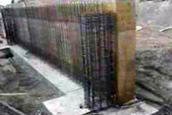 |
While standing on a rebar column he is in the process of plumbing, a worker in full body harness attempts to hook his lanyards onto a location over his head.
|
 |
The hook slips, and the worker falls approximately 8 feet (2,5 m) to the footings below, where he is impaled through the groin on a protruding rebar.
|
 |
Though the rebar is capped, the force of the worker's fall pushes the cap clear to the ground, and bends the rebar nearly 45 degrees.
|
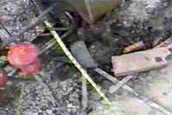 |
This is an example of the rebar caps used at this site. Because it was not steel reinforced, it was insufficient to provide protection in a fall from elevation.
|
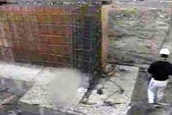 |
An employee passing by the accident site gives perspective to the height involved. The victim was only standing approximately at the top of this image, yet the force of his fall bent the rebar like a coat hanger. Luckily, he was taken by helicopter to a nearby hospital and survived his injuries.
|
Fotos courtesy of Utah Occupational Safety and Health Division
Covercaps in overview
* |
Scratch protection
Offers NO protection against impalement! |
|
* |
Impalement Protection
|
|
The Best of all Worlds
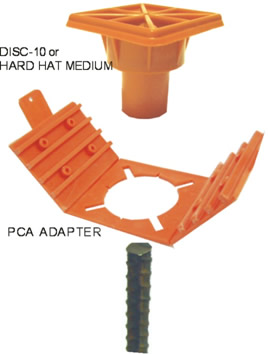 |
||
* |
Impalement Protection:
|


